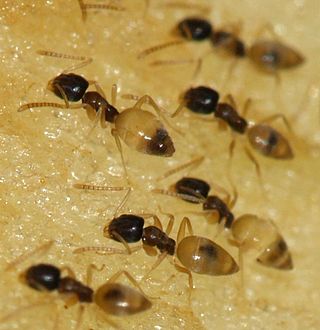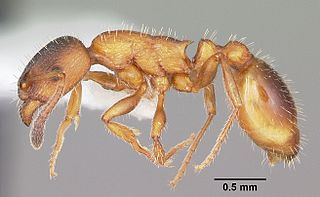
The erratic ant is a species of dolichoderine ant first described in 1789 by Latreille.

The Formica rufa group is a subgeneric group within the genus Formica, first proposed by William Morton Wheeler. This group contains the mound-building species of Formica commonly termed "wood ants" or "thatch-mound ants", which build prominent nests consisting of a mound of grass, litter, or conifer needles. The species Formica rufa or the red wood ant is the type species of this subgroup.

Tapinoma is a genus of ants that belongs to the subfamily Dolichoderinae. The genus currently comprises 74 described species distributed worldwide in tropical and temperate regions. Members of are generalized foragers, nesting in a wide variety of habitats, ranging from grasslands, open fields, woodlands, to inside buildings. The majority of species nest in the ground under objects such as stones or tree logs, other species build nests under bark of logs and stumps, in plant cavities, insect galls or refuse piles.

Myrmica is a genus of ants within the subfamily Myrmicinae. It is widespread throughout the temperate regions of the Holarctic and high mountains in Southeast Asia.

Leptothorax is a genus of small ants with mainly Holarctic distributions. The genus is notable for its widespread social parasitism, i.e. they are dependent on the help of workers from other ant species during a part or the whole of their life cycles.

Proformica is a genus of ants in the subfamily Formicinae. The genus is known from the Palearctic realm, from Mongolia through Central Asia to Spain. Colonies are small, generally containing a few hundred individuals, with a single queen (monogyne) or multiple ergatogyne queens. Unique in the tribe Formicini, some species have specialized workers gorged with food; they function as living storage containers.
Tapinoma glaesaria is an extinct species of ant in the genus Tapinoma. Originally described by Gennady Dlussky in 2002 as Tapinoma aberrans, fossils of the species were found in the Rovno amber in Ukraine. The original specific name was a secondary homonym of Tapinoma aberrans, an extant species from Madagascar. Perrichot, Salas-Gismondi & Antoine (2019) coined a replacement name T. glaesaria for the taxon described by Dlussky.

Tapinoma annandalei is a species of ant in the genus Tapinoma. Described by William Morton Wheeler in 1928, the species is endemic to India.
Tapinoma demissum is a species of ant in the genus Tapinoma. Described by Bolton in 1995, the species is endemic to Tanzania and Zimbabwe.

Tapinoma emeryi is a species of ant in the genus Tapinoma. Described by Ashmead in 1905, the species is endemic to Tanzania and Philippines.
Tapinoma festae is a species of ant in the genus Tapinoma. Described by Emery in 1925, the species is endemic to Greece, Iran and Turkey.
Tapinoma indicum is a species of ant in the genus Tapinoma. Described by Forel in 1895, the species is endemic to various countries in Asia.
Tapinoma krakatauae is a species of ant in the genus Tapinoma. Described by William Morton Wheeler in 1924, the species is endemic to Indonesia.
Tapinoma madeirense is a species of ant in the genus Tapinoma. Described by Forel in 1895, the species is endemic to various countries to many countries throughout Europe.
Tapinoma rasenum is a species of ant in the genus Tapinoma. Described by Smith and Lavigne in 1973, the species is endemic to Puerto Rico.

Tapinoma simrothi is a species of ant in the genus Tapinoma. Described by Krausse in 1911, the species is endemic to many countries spanning in Africa, Asia and Europe.
Tapinoma subboreale is a species of ant in the genus Tapinoma. Described by Seifert in 2012, the species is endemic to Europe.

Tapinoma wilsoni is a species of ant in the genus Tapinoma. Described by Sharaf and Aldawood in 2012, the species is endemic to Saudi Arabia.

An ant supercolony is an exceptionally large ant colony, consisting of a high number of spatially separated but socially connected nests of a single ant species, spread over a large area without territorial borders. Supercolonies are typically polygynous, containing many egg-laying females. Workers and queens from different nests within the same supercolony can freely move among the nests, and all workers cooperate indiscriminately with each other in collecting food and care of the brood, and show no apparent mutual aggressive behavior.











